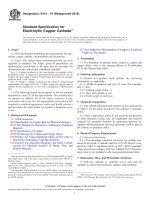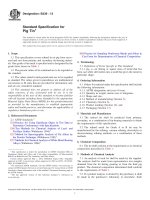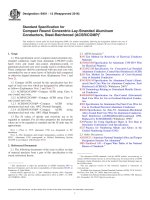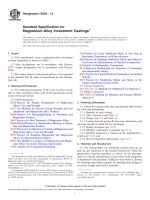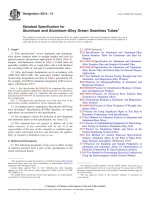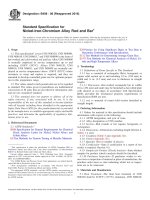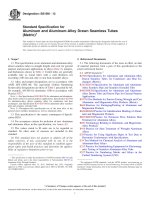Astm b 401 12 (2016)
Bạn đang xem bản rút gọn của tài liệu. Xem và tải ngay bản đầy đủ của tài liệu tại đây (114.32 KB, 5 trang )
Designation: B401 − 12 (Reapproved 2016)
Standard Specification for
Compact Round Concentric-Lay-Stranded Aluminum
Conductors, Steel-Reinforced (ACSR/COMP)1
This standard is issued under the fixed designation B401; the number immediately following the designation indicates the year of
original adoption or, in the case of revision, the year of last revision. A number in parentheses indicates the year of last reapproval. A
superscript epsilon (´) indicates an editorial change since the last revision or reapproval.
2.2 ASTM Standards:2
B193 Test Method for Resistivity of Electrical Conductor
Materials
B230/B230M Specification for Aluminum 1350–H19 Wire
for Electrical Purposes
B232/B232M Specification for Concentric-Lay-Stranded
Aluminum Conductors, Coated-Steel Reinforced (ACSR)
B263 Test Method for Determination of Cross-Sectional
Area of Stranded Conductors
B341/B341M Specification for Aluminum-Coated (Aluminized) Steel Core Wire for Aluminum Conductors, Steel
Reinforced (ACSR/AZ) (Withdrawn 2007)3
B354 Terminology Relating to Uninsulated Metallic Electrical Conductors
B498/B498M Specification for Zinc-Coated (Galvanized)
Steel Core Wire for Use in Overhead Electrical Conductors
B502 Specification for Aluminum-Clad Steel Core Wire for
Use in Overhead Electrical Aluminum Conductors
B802M Specification for Zinc-5% Aluminum-Mischmetal
Alloy-Coated Steel Core Wire for Aluminum Conductors,
Steel Reinforced (ACSR)[Metric](Discontinued 1998Replaced by B 802/B802M) (Withdrawn 1998)3
E29 Practice for Using Significant Digits in Test Data to
Determine Conformance with Specifications
E527 Practice for Numbering Metals and Alloys in the
Unified Numbering System (UNS)
1. Scope
1.1 This specification covers compact round concentric-laystranded conductors made from aluminum 1350-H19 (extra
hard) wires and round zinc-coated, aluminum-coated, or
aluminum-clad steel core wires usually used in overhead lines.
These conductors shall be constructed with one steel core wire
surrounded by one or more layers of helically-laid compacted
or otherwise shaped aluminum wires (Explanatory Note 1 and
Note 2).
1.2 Compact ACSR covered by this specification has five
types of steel core wire which are designated by abbreviations
as follows (Explanatory Note 2 and Note 7).
1.2.1 ACSR/GA2/COMP—Compact ACSR using Class A
zinc-coated steel wire,
1.2.2 ACSR/GC2/COMP—Compact ACSR using Class C
zinc-coated steel wire,
1.2.3 ACSR/AW2/COMP—Compact
ACSR
using
aluminum-clad steel wire, AW2 (Normal Strength).
1.2.4 ACSR/AW3/COMP—Compact
ACSR
using
aluminum-clad steel wire, AW3 (High Strength).
1.3 The SI values of density and resistivity are to be
regarded as standard. For all other properties the inch-pound
values are to be regarded as standard and the SI units may be
approximate.
NOTE 1—Prior to 1975, aluminum 1350 was designated as EC
aluminum.
NOTE 2—The aluminum and temper designations conform to ANSI
H35.1. Aluminum 1350 corresponds to Unified Numbering System
A91350 in accordance with Practice E527.
2.3 Other Documents:
ANSI H35.1 American National Standard Alloy and Temper
Designation Systems For Aluminum4
NBS Handbook 100 —Copper Wire Tables of the National
Bureau of Standards 5
2. Referenced Documents
2.1 The following documents of the issue in effect on date
of material purchase form a part of this specification to the
extent referenced herein.
2
For referenced ASTM standards, visit the ASTM website, www.astm.org, or
contact ASTM Customer Service at For Annual Book of ASTM
Standards volume information, refer to the standard’s Document Summary page on
the ASTM website.
3
The last approved version of this historical standard is referenced on
www.astm.org.
4
Available from American National Standards Institute (ANSI), 25 W. 43rd St.,
4th Floor, New York, NY 10036, .
5
Available from National Technical Information Service (NTIS), 5301 Shawnee
Rd., Alexandria, VA 22312, .
1
This specification is under the jurisdiction of ASTM Committee B01 on
Electrical Conductors and is the direct responsibility of Subcommittee B01.07 on
Conductors of Light Metals.
Current edition approved Oct. 1, 2016. Published October 2016. Originally
approved in 1963. Last previous edition approved in 2012 as B401 – 12. DOI:
10.1520/B0401-12R16.
Copyright © ASTM International, 100 Barr Harbor Drive, PO Box C700, West Conshohocken, PA 19428-2959. United States
1
B401 − 12 (2016)
5.5 The direction of lay shall be reversed in successive
layers.
3. Ordering Information
3.1 Orders for material under this specification shall include
the following information:
3.1.1 Quantity of each size and stranding (Table 1),
3.1.2 Conductor size: circular-mil area or AWG (Section 6,
and Table 1),
3.1.3 Steel wire coating or aluminum-clad (see 11.3),
3.1.4 Special tension test, if required (see 15.3),
3.1.5 Place of inspection (Section 16), and
3.1.6 Packaging and Package Marking (Section 17).
6. Construction
6.1 The diameter of the steel core wire, the number of
aluminum wires, the aluminum cross-sectional area, the diameter and weight of the compact round concentric-lay-stranded
aluminum conductors, steel-reinforced, shall be as shown in
Table 1.
7. Rated Strength of Conductor
7.1 The rated strength of a completed conductor shall be
taken as the aggregate strength of the aluminum and steel
components, calculated as follows: The strength contribution
of the aluminum wires shall be taken as the percentage,
according to the number of layers of aluminum wires, indicated
in Table 2, of the sum of the strengths of the 1350-H19 wires,
calculated on the basis of the nominal wire diameter for the
corresponding noncompacted construction given in Specification B232/B232M and the appropriate specified minimum
average tensile strength given in Specification B230/B230M.
The strength contribution of the steel core shall be taken as
96 % of the strength of the steel wire calculated from its
specified nominal diameter and the appropriate specified minimum stress at 1 % extension given in Specification B341/
B341M, B498/B498M, B502, or B802M, whichever is applicable.
4. Joints
4.1 Electric-butt welds, electric-butt, cold-upset welds, or
cold-pressure welds in the individual round-drawn or shaped
aluminum wires may be made during the stranding process. No
weld shall occur within 50 ft (15 m) of a weld in the same wire
or in any other wire of the completed conductor.
4.2 There shall be no joints of any kind made in the finished
coated, or aluminum-clad steel wires.
5. Lay
5.1 The preferred lay of the aluminum wires of aluminum
conductors, steel-reinforced, having a single wire steel core
and one layer of aluminum wires is 14 times the outside
diameter of the conductor but the lay shall be not less than 13
nor more than 16 times that diameter.
5.2 The preferred lay of the outside layer of aluminum wires
of aluminum conductors, steel-reinforced, having multiple
layers of aluminum wires is 12 times the outside diameter of
the conductor but the lay shall be not less than 11 nor more
than 14 times that diameter.
7.2 Rated strength and breaking strength values shall be
rounded to three significant figures, in the final value only, in
accordance with Practice E29.
5.3 The preferred lay of the layer immediately beneath the
outside layer of aluminum wires of aluminum conductors,
steel-reinforced, having multiple layers of aluminum wires is
14 times the outside diameter of such layer but the lay shall be
not less than 11 nor more than 17.5 times that diameter.
8. Density
7.3 Rated strength of conductors are given in Table 3.
8.1 For the purpose of calculating mass, mass per unit
length, cross sections, and so forth, the density of aluminum
1350 shall be taken as 2705 kg/m3 (0.0975 lb/in.3) at 20°C.
8.2 For the purpose of calculating mass, mass per unit
length, cross sections, and so forth, the density of coated steel
wire shall be taken as 7780 kg/m3 (0.281 lb ⁄in.3) at 20°C.
5.4 The direction of lay of the outside layer of aluminum
wires shall be right hand.
TABLE 1 Construction Requirements for Compact Round Concentric-Lay-Stranded Aluminum Conductors, Steel Reinforced
Required Construction
Conductor Size
(Aluminum Wires)
cmil
mm2
AWG
336 400
266 800
211 600
167 800
133 100
105 600
83 690
66 360
66 360
52 620
41 740
41 740
26 240
170.2
135.0
107.2
85.1
67.3
53.5
42.4
33.6
33.6
26.7
21.1
21.2
13.3
...
...
0000
000
00
0
1
2
2
3
4
4
6
Number of
Aluminum
Wires
18
18
6
6
6
6
6
7
6
6
7
6
6
Nominal Mass for Conductors With:
Compact
Conductor
Diameter
Steel Wire
Diameter
Coated Steel
Core Wire
Aluminum-Clad
Steel Core Wire
in.
mm
in.
mm
lb/1000 ft
kg/km
lb/1000 ft
kg/km
0.1367
0.1217
0.1878
0.1672
0.1489
0.1327
0.1181
0.1299
0.1052
0.0937
0.1029
0.0834
0.0661
3.47
3.09
4.77
4.25
3.78
3.37
3.00
3.30
2.67
2.38
2.61
2.12
1.68
0.628
0.559
0.517
0.461
0.410
0.365
0.326
0.298
0.290
0.258
0.236
0.229
0.182
15.95
14.20
13.13
11.71
10.41
9.27
8.28
7.57
7.37
6.55
5.99
5.82
4.62
364.8
289.1
290.8
230.5
182.8
145.2
115.0
106.6
91.2
72.4
67.0
57.3
36.0
543.3
430.8
433.4
343.9.0
272.3
216.4
171.4
158.6
135.9
107.9
99.7
85.6
53.7
357.2
283.1
276.5
219.2
173.8
138.1
109.4
99.8
86.8
68.8
62.7
54.5
...
531.1
421.1
412.1
327.1
258.9
205.8
163.0
148.4
129.2
102.6
93.4
81.4
...
2
B401 − 12 (2016)
TABLE 2 Strength Rating Factors
Stranding
Number of Wires
Number of Layers
Aluminum
Steel
Aluminum
Steel
A
6
1
1
A
7
1
1
A
18
1
2
12. Variation in Area
Rating Factor, %
Aluminum
Steel
96
96
93
96
96
96
12.1 The cross-sectional area of the aluminum in wires of a
compact round ACSR shall be not less than 98 % of the
cross-sectional area as specified in column 1 of Table 1. The
manufacturer shall determine the cross-sectional area by Test
Method B263. In applying this method, the increment in
weight resulting from stranding may be the applicable value
specified in 9.1 or may be calculated from the measured
dimensions of the sample under test. In case of question
regarding area compliance, the actual mass increment due to
stranding shall be calculated.
A
Central steel wire only: the 96 % Rating Factor is applied to the single steel wire
core in the event it contains a weld (made prior to drawing).
8.3 For the purpose of calculating mass, mass per unit
length, cross sections, and so forth, the density of aluminumclad steel wire shall be taken as 6590 kg/m3 (0.2381 lb/in.3) at
20°C.
13. Variation in Diameter
13.1 The diameter of the compact round ACSR shall vary
by not more than +1 –2 % from the diameter specified in Table
1.
9. Mass and Electrical Resistance
14. Sampling
9.1 The mass and electrical resistance of a unit length of
stranded conductor are a function of the length of lay. The
approximate mass and electrical resistance may be determined
using an increment of 1.5 % for conductors composed of 1
steel and 6 or 7 aluminum wires and an increment of 2 % for
conductors composed of 1 steel and 18 aluminum wires. When
greater accuracy is desired, the increment based on the specific
lay of the conductor may be calculated (Explanatory Note 4).
14.1 The aluminum cross-sectional area (Section 12) and
the conductor diameter (Section 13) shall be measured on a
sample of completed conductor. At least one sample shall be
tested for each size of conductor on each order of quantities
from 5000 to 100 000 ft (1500 to 30 000 m) and one
additional sample tested from each 100 000 ft thereafter.
15. Mechanical and Electrical Tests
9.2 In the calculation of the electrical resistance of a
completed conductor, coated steel wires may be included.
15.1 Tests for mechanical and electrical properties of aluminum wires composing the conductors shall be made before
stranding (Explanatory Note 5).
9.3 The maximum electrical resistance of a unit length of
stranded conductor shall not exceed 102 % of the nominal dc
resistance shown in Table 4 (Explanatory Note 6). When the dc
resistance is measured at other than 20°C, it is to be corrected
by using the multiplying factor given in Table 5.
15.2 Tests for the mechanical and electrical properties of the
steel core wire shall be made before, but not after stranding,
unless otherwise agreed by the manufacturer and the purchaser
as provided in 15.3 (Explanatory Note 5).
9.4 For conductors to be used in covered or insulated wires
or cables dc resistance measurements may be used in lieu of the
method outlined in Section 12.
15.3 At the option of the purchaser, at the time of placing
the order, tension and elongation tests of wire before stranding
may be waived, and the completed conductor may be tested as
a unit. The minimum breaking strength of conductors so tested
shall be not less than the rated strength if failure occurs in the
free length at least 1 in. (25 mm) beyond the end of either
gripping device, or shall be not less than 95 % of the rated
strength if failure occurs inside, or within 1 in. of the end of,
either gripping device. The free length between grips of the test
specimen shall be not less than 24 in. (600 mm), and care shall
be taken to ensure that the wires in the conductor are evenly
gripped during the test (Explanatory Note 3).
10. Workmanship, Finish, and Appearance
10.1 The conductor shall be clean and free of imperfections
not consistent with good commercial practice.
11. Requirements for Wires
11.1 Before stranding and compacting, the round aluminum
wire used shall conform to the requirements of Specification
B230/B230M.
11.2 Aluminum wires shaped before stranding shall meet
the requirements of Specification B230/B230M, except for
shape, tensile and elongation requirements, and diameter
tolerances. The minimum tensile and elongation requirements
shall be 96 % of those for round wires of the same nominal
area, provided the completed conductor is capable of meeting
the requirements of Section 7. The area tolerances for the
shaped wires shall be such that the finished conductor conforms to Section 12.
16. Inspection
16.1 Unless otherwise specified in the contract or purchase
order, the manufacturer shall be responsible for the performance of all inspection and test requirements specified.
16.2 All inspections and tests shall be made at the place of
manufacture unless otherwise agreed to between the manufacturer and the purchaser at the time of purchase.
16.3 The manufacturer shall afford the inspector representing the purchaser all reasonable manufacturer’s facilities to
satisfy him that the material is being furnished in accordance
with this specification.
11.3 Before stranding, the steel core wire used shall conform to the requirements of Specification B341/B341M, B498/
B498M, B502, or B802M, whichever is applicable.
3
B401 − 12 (2016)
TABLE 3 Rated Strengths for Compact Round Concentric-Lay-Stranded Aluminum Conductors, Steel-Reinforced
Rated Strength For Conductors With:
AluminumCoated
Steel Core
Wire
Conductor Size
mm
AWG
Number of
Aluminum
Wires
170.2
135.0
107.2
85.1
67.3
53.5
42.4
33.6
33.7
26.7
21.1
21.2
13.3
...
...
0000
000
00
0
1
2
2
3
4
4
6
18
18
6
6
6
6
6
7
6
6
7
6
6
2
cmil
336 400
266 800
211 600
167 800
133 100
105 600
83 690
66 360
66 360
52 620
41 740
41 740
26 240
Aluminum-Clad
Steel Core Wire
Coated Steel Core Wire:
Class A
Class B
Class C
kips
kN
kips
kN
kips
kN
kips
kN
kips
kN
8.26
6.54
7.42
5.88
4.88
3.98
3.29
3.26
2.64
2.13
2.16
1.76
1.12
36.3
28.81
32.9
26.1
21.4
17.6
14.4
14.4
11.7
9.44
9.60
7.83
4.98
8.54
6.82
7.69
6.30
5.13
4.25
3.45
3.51
2.76
2.23
2.28
1.78
Not
Standard
37.6
30.0
34.1
28.0
22.5
18.8
15.1
15.6
12.3
9.89
10.1
7.95
Not
Standard
8.68
6.88
8.35
6.62
5.30
4.38
3.55
3.64
2.85
2.29
2.36
1.86
1.19
38.2
30.3
37.1
29.4
23.3
19.4
15.6
16.1
12.7
10.2
10.5
8.30
5.28
8.54
6.77
8.08
6.41
5.13
4.25
3.45
3.51
2.76
2.23
2.28
1.81
1.16
37.5
29.8
35.9
28.5
22.5
18.8
15.1
15.6
12.3
9.91
10.2
8.07
5.13
8.40
6.66
7.95
6.30
5.05
4.12
3.34
3.39
2.68
2.17
2.20
1.76
1.12
36.9
29.3
35.3
28.1
22.2
18.2
14.7
15.0
11.9
9.61
9.81
7.83
4.98
TABLE 4 Nominal dc Resistance Values
Required Construction
Conductor Size
(Aluminum Wires)
cmil
mm2
Number of
Aluminum
Wires
AWG
336 400
266 800
211 600
167 800
133 100
105 600
83 690
66 360
66 360
52 620
41 740
41 740
26 240
170.2
135.0
107.2
85.1
67.3
53.5
42.4
33.6
33.6
26.7
21.1
21.2
13.3
...
...
0000
000
00
0
1
2
2
3
4
4
6
18
18
6
6
6
6
6
7
6
6
7
6
6
Nominal dc Resistance @ 20°C for Conductors With:
Steel Wire
Diameter
Coated Steel
Core Wire
Aluminum-Clad
Steel Core Wire
in.
mm
ohm/1000 ft
ohm/km
ohm/1000 ft
ohm/km
0.1367
0.1217
0.1878
0.1672
0.1489
0.1327
0.1181
0.1299
0.1052
0.0937
0.1029
0.0834
0.0661
3.472
3.091
4.770
4.247
3.782
3.371
3.000
3.299
2.672
2.380
2.614
2.118
1.679
0.05113
0.06451
0.07956
0.1004
0.1266
0.1594
0.2012
0.2503
0.2536
0.3203
0.3985
0.4034
0.6423
0.1680
0.2118
0.2611
0.3288
0.4157
0.5230
0.6600
0.8239
0.8332
1.049
1.309
1.322
2.104
0.05060
0.06384
0.07720
0.09739
0.1228
0.1546
0.1952
0.2393
0.2460
0.3107
0.3809
0.3914
...
0.1662
0.2096
0.2533
0.3191
0.4033
0.5074
0.6403
0.7874
0.8084
1.017
1.251
1.282
...
TABLE 5 Temperature Correction Factors for Conductor
Resistance
17. Packaging and Package Marking
17.1 Package sizes and kind of package, reels, or coils shall
be agreed upon between the manufacturer and the purchaser.
17.2 The conductors shall be protected against damage in
ordinary handling and shipping.
17.3 There shall be only one length of conductor on a reel.
17.4 The net mass, length, size, kind of conductor,
stranding, kind of coating, class of zinc coating (if used), and
any other necessary identification shall be marked on a tag
attached to the end of the conductor inside the package. This
same information, together with the purchase order number,
the manufacturer’s serial number (if any), and all shipping
marks and other information required by the purchaser shall
appear on the outside of the package.
Temperature, °C
Multiplying Factor for
Conversion to 20°C
0
5
10
15
20
25
30
35
40
1.088
1.064
1.042
1.02
1.00
0.98
0.961
0.943
0.925
NOTE 1—Although the temperature coefficient of aluminum is different
from steel, the approximate temperature correction factor is given in the
above chart. For a more accurate conductor resistance calculation the
individual resistance temperature coefficient for the aluminum and for the
steel must be included in the dc resistance equations shown in Explanatory
Note 6. As per ASTM B193, the 20°C temperature coefficient of resistance
for 1350 aluminium at 61.0 % IACS is 0.00403. The 20°C temperature
coefficient of resistance for aluminum clad steel at 20.3 %IACS is
0.00306. The 20°C temperature coefficient of resistance for zinc or
aluminum coated steel is not defined in ASTM B193, however a
approximated value of 0.005 has been used.
4
B401 − 12 (2016)
18. Keywords
stranded conductors; concentric-lay-stranded conductors; electrical conductor; electrical conductor-aluminum; steelreinforced conductors; stranded conductors
18.1 aluminum conductors; aluminum conductors; steelreinforced; aluminum electrical conductor; compact round
EXPLANATORY NOTES
NOTE 1—In this specification, only compact round concentric-laystranded aluminum conductors, steel-reinforced, are specially designated.
Conductor constructions not included in this specification should be
specifically agreed upon between the manufacturer and the purchaser at
the time of purchase.
NOTE 2—For definitions and terms relating to conductors, reference
should be made to Terminology B354.
NOTE 3—To test stranded conductors for breaking strength successfully
as a unit requires adequate means of gripping the ends of the test specimen
without causing damage that may result in failure below the actual
strength of the conductor. Various means are available, such as compression sleeves, split sleeves, and preformed grips, but ordinary jaws or
clamping devices usually are not suitable.
NOTE 4—The increment of mass, mass per unit length, or electrical
resistance of a completed concentric-lay-stranded conductor, k, in percent
is:
R5
S F GD
1
1
1
1
Ra Rc
where:
Ra = dc resistance at 20°C for the aluminum strand wires, and
Rc = dc resistance at 20°C for the steel core.
Inch-Pound Units:
Ra 5
Rc 5
S
S
D
D
k
ρa
11 3
100
Aa
ρc
k
11 3
100
Ac
Metric Units:
Ra 5
k 5 100~ m 2 1 !
where m is the stranding factor, and is also the ratio of the mass or
electrical resistance of a unit length of stranded conductor to that of a solid
conductor of the same cross-sectional area or of a stranded conductor with
infinite length of stranding, that is, all wires parallel to the conductor axis.
The stranding factor m for the completed stranded conductor is the
numerical average of the stranding factors for each of the individual wires
in the conductor, including the straight core wire, if any (for which the
stranding factor is unity). The stranding factor (mind) for any given wire
in a concentric-lay-stranded conductor is:
Rc 5
S
S
D
D
ρa
k
3 1000
11 3
100
Aa
ρc
k
11 3 3 1000
100
Ac
where:
R =
Ra =
Rc =
k
=
conductor dc resistance in Ω/1000 ft (Ω/km) at 20°C,
aluminum strand wire dc resistance in Ω/1000 ft (Ω/km) at 20°C,
steel core wire dc resistance in Ω/1000 ft (Ω/km) at 20°C,
increment due to stranding = 2 (from Section 11) and Explanatory
Note 4,
ρa = volume resistivity in ohms-cmil/ft (Ω-mm2/m), for the aluminum
strand wires determined in accordance with Test Method B193,
ρc = volume resistivity in ohms-cmil/ft (Ω-mm2/m), for the steel core
wire determined in accordance with Test Method B193,
Aa = cross-sectional area of aluminum strand wires in the conductor in
kcmil (mm2) determined in accordance with Section 12 of this
specification, and
Ac = cross-sectional area of the steel core wire in kcmil (mm2)
determined in accordance with Section 12 of this specification.
NOTE 7—Some of the abbreviations for standard aluminum conductors
with steel core have changed. The following tabulation shows the new
designations and the prior designations:
ACSR/GA2/COMP—was ACSR/GA/COMP
ACSR/GC2/COMP—was ACSR/GC/COMP
ACSR/AW2/COMP—was ACSR/AW/COMP
ACSR/AW3/COMP—none
m ind 5 =11 ~ 9.8696/n 2 !
length of lay
diameter of helical path of wire
The derivation of the above as given in NBS Handbook 100 is based on
the round-wire constructions which are applicable to compacted wire
constructions.
NOTE 5—Individual wires are not to be unlaid from compact round
conductors for testing purposes. Some physical properties of the individual wires may be altered by the deformation brought about by
compacting, unlaying, and straightening for test. If tests on steel wires are
to be made after stranding, the purchaser and the manufacturer should
agree on the properties to be met at the time of placing the order.
NOTE 6—The dc resistance on a given construction shall be calculated
using the following formula:
where n 5
ASTM International takes no position respecting the validity of any patent rights asserted in connection with any item mentioned
in this standard. Users of this standard are expressly advised that determination of the validity of any such patent rights, and the risk
of infringement of such rights, are entirely their own responsibility.
This standard is subject to revision at any time by the responsible technical committee and must be reviewed every five years and
if not revised, either reapproved or withdrawn. Your comments are invited either for revision of this standard or for additional standards
and should be addressed to ASTM International Headquarters. Your comments will receive careful consideration at a meeting of the
responsible technical committee, which you may attend. If you feel that your comments have not received a fair hearing you should
make your views known to the ASTM Committee on Standards, at the address shown below.
This standard is copyrighted by ASTM International, 100 Barr Harbor Drive, PO Box C700, West Conshohocken, PA 19428-2959,
United States. Individual reprints (single or multiple copies) of this standard may be obtained by contacting ASTM at the above
address or at 610-832-9585 (phone), 610-832-9555 (fax), or (e-mail); or through the ASTM website
(www.astm.org). Permission rights to photocopy the standard may also be secured from the Copyright Clearance Center, 222
Rosewood Drive, Danvers, MA 01923, Tel: (978) 646-2600; />
5

